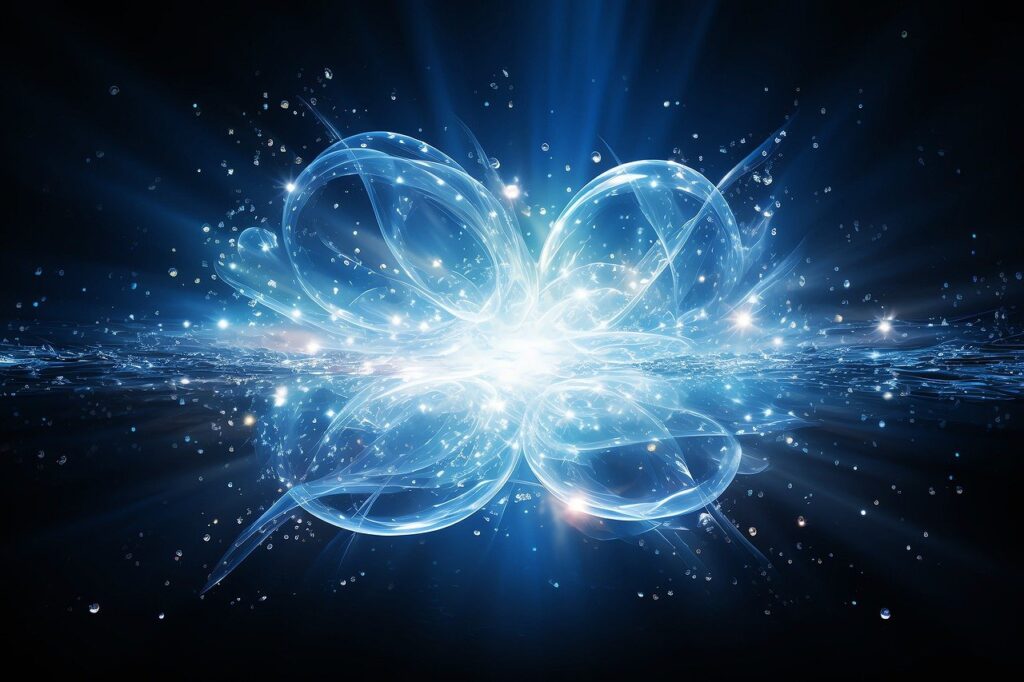This article will discuss the evolution of Gaussian states under the born-markov master equation of a harmonic oscillator coupled to a heat bath made up of many harmonic oscillators. We are going to prove the fact that this master equation evolves Gaussian states again into Gaussian states. Specifically, we will look at the case of a displaced thermal state. To understand our approach, it is necessary to comprehend SU(1,1) algebra, the SU(1,1) Disentangling theorem, and the Disentanglement Formula for Two-Generator Lie Algebra. All these topics and relevant information are summarized in this article.
The solution of the master equation for the physical model, described in our previous articles: https://quantumthermodynamic.com/open-quantum-systems-and-master-equations/
The solution can be expressed as:
\begin{equation}
|\rho_S (t)\rangle= \exp{\Big(\gamma_0 K_0 + kt\Big)}\exp{\Big(\gamma_{+} K_{+} + \gamma_3 K_3 + \gamma_{-} K_{-} \Big)} |\rho_S (0)\rangle \nonumber
\end{equation}
Where $$ \gamma_0 = -i\omega_0 t,\hspace{5pt}\gamma_{-} =2k(1+n_0)t $$ $$\gamma_3 = -2k(2n_0 + 1)t,\hspace{2pt}\gamma_{+} = 2kn_0t$$ $$ \gamma = 2k$$
To understand how this solution is derived, please read here: https://quantumthermodynamic.com/operator-method-to-solve-the-master-equation/
To start, consider the following displaced thermal state as the initial state of the system:
\begin{equation} \rho(0) = (1-f(0)) D(\alpha) e^{-\beta(0) a^{\dagger}a}D^{\dagger}(\alpha) \xrightarrow{TFD}
|\rho(0)\rangle = e^{\bar{n}(K_{+} + K_{-} – 2K_{3})}|\alpha,\alpha^{*}\rangle\nonumber \end{equation}
The symbol TFD denotes the thermo-field dynamics – Which is summarized here: https://quantumthermodynamic.com/introduction-to-thermo-field-dynamics/
Putting back the given initial state in the final solution of the master equation and rewriting:
$$ \gamma_{+} K_{+} + \gamma_3 K_3 + \gamma_{-} K_{-}= 2kn_{0}t(K_{+} + K_{-} – 2K_3) + 2kt(K_{-} – K_{3}) $$
We obtain the following expression –
\begin{equation} |\rho_S (t)\rangle = \exp{(\gamma_0 K_0 + kt)}e^{2kn_{0}t(K_{+} + K_{-} – 2K_3) + 2kt(K_{-} – K_{3})} e^{\bar{n}(K_{+} + K_{-} – 2K_{3})}|\alpha,\alpha^{*}\rangle \nonumber \end{equation}
After this step, we can now make use of the Disentanglement Formula for Two-Generator Lie Algebra as explained below:
Disentanglement Formula for Two-Generator Lie Algebra: For two generators that fulfill the following commutation relation
\begin{equation}
[X,Y] = \lambda Y\nonumber
\end{equation}
Then, we can write the disentanglement formulas as
\begin{equation}
e^{(c_1X + c_2Y)} = e^{aX} e^{bY} = e^{b’Y} e^{a’X}\nonumber
\end{equation}
Where \(
a = a’ = c_1, b = \frac{c_2}{\lambda c_1} (1-e^{-\lambda c_1})\), \(b^{‘} = \frac{c_2}{\lambda c_1} (e^{ \lambda c_1}-1)\)
For our case, consider the following
\begin{equation}
X = K_{-} – K_{3},\hspace{2pt} Y = K_{+} + K_{-} – 2K_3 \nonumber
\end{equation}
Then, we can easily find out that \( [X, Y] = -Y \) implies \(\lambda = -1\).
The formula described above can be used to rewrite:
\begin{equation} e^{2kn_{0}t(K_{+} + K_{-} – 2K_3) + 2kt(K_{-} – K_{3})} = e^{a(K_{-} – K_{3})} e^{b(K_{+} + K_{-} – 2K_3)} \nonumber \end{equation}
Where \(a = 2kt\) and \(b= n_0(-1+e^{2kt})\). By doing this, we are able to express the state of the system in the following form –
\begin{equation} |\rho_S (t)\rangle = \exp{\Big(\gamma_0 K_0 + kt\Big)} e^{a(K_{-} – K_{3})} e^{b(K_{+} + K_{-} – 2K_3)} e^{\bar{n}(K_{+} + K_{-} -2K_{3})}|\alpha,\alpha^{*}\rangle \nonumber \end{equation}
This can be further simplified to:
\begin{equation} |\rho_S (t)\rangle= \exp{\Big(\gamma_0 K_0 + kt\Big)} e^{2kt(K_{-} – K_{3})} e^{\bar{n’}(K_{+} + K_{-} – 2K_3)} |\alpha,\alpha^{*}\rangle\nonumber \end{equation}
Where \(\bar{n’} = \bar{n} + b = n_0(e^{2kt} – 1) + \bar{n}\). Now, using again the disentangling formula to rewrite
\begin{equation} e^{2kt(K_{-} – K_{3})} e^{\bar{n’}(K_{+} + K_{-} – 2K_3)} = e^{c_1(K_{-} – K_{3}) + c_2 (K_{+} + K_{-} – 2K_3)} \nonumber \end{equation}
With \(c_1 = 2kt\), and \(c_2 = \frac{-2kt \bar{n’}}{1-e^{2kt}}\) to yield the following form
\begin{equation} |\rho_S (t)\rangle = \exp{\Big(\gamma_0 K_0 + kt\Big)} e^{c_1(K_{-} – K_{3}) + c_2 (K_{+} + K_{-} – 2K_3)} |\alpha,\alpha^{*}\rangle \nonumber \end{equation}
Once more, we can apply the disentangling formula to get the state of the system as
\begin{equation} |\rho_S (t)\rangle = \exp{\Big(\gamma_0 K_0 + kt\Big)} e^{\bar{\bar{n}} (K_{+} + K_{-} – 2K_3)} e^{2kt(K_{-} – K_{3})} |\alpha,\alpha^{*}\rangle\nonumber \end{equation}
Where \( \bar{\bar{n}}= n_0 (-e^{-2kt} + 1)-\bar{n}e^{-2kt} \)
Now, by using SU(1,1) disentangling theorem to rewrite
\begin{equation} e^{2kt(K_{-} – K_{3})} = e^{(\log(\bar{\Gamma}_3))K_3} e^{\bar{\Gamma}_{-}K_{-}} \end{equation}
With:
$$ \bar{\Gamma}_{3} = e^{-2kt}, \hspace{1pt} \bar{\Gamma}_{-} = 1-e^{-2kt} $$
Performing some simple algebra on a coherent state, we can get:
\begin{equation} |\rho_S (t)\rangle = e^{\bar{\bar{n}} (K_{+} + K_{-} – 2K_3)} |\alpha e^{-iw_0 t} e^{-kt},\alpha^{*} e^{iw_0 t} e^{-kt}\rangle \nonumber \end{equation} \begin{equation} |\rho_S (t)\rangle = \frac{1}{1+ \bar{\bar{n}}} D(\alpha e^{-i\omega_0 t} e^{-kt}) \tilde{D}(\alpha^{*} e^{i\omega_0 t} e^{-kt}) e^{\frac{\bar{\bar{n}}}{1 + \bar{\bar{n}}} K_{+}} |0,0\rangle \nonumber \end{equation} \begin{equation} {\rho_S (t) = (1-f(t)) D(\alpha e^{-i\omega_0 t}e^{-kt}) e^{-\beta(t) a^{\dagger}a} D^{\dagger}(\alpha e^{-i\omega_0 t}e^{-kt}) } \nonumber \end{equation}
Which is again a displaced thermal state. Where \( f(t) = e^{-\beta(t)}, \hspace{2pt} \bar{\bar{n}} = \frac{f(t)}{1-f(t)}\), \(\bar{\bar{n}} = n_0 – e^{-2kt}(n_0 – \bar{n})\).
References:
[1] Daniel Scholz, Volodymyr G Voronov, and Michael Weyrauch. “Approximately disentangling exponential operators.” In: Journal of Mathematical Physics 51.6 (2010), p. 063513.
[2] Ananda DasGupta. “Disentanglement formulas: An alternative derivation and some applications to squeezed coherent states.” In: American Journal of Physics 64.11 (1996), pp. 1422–1427.
[3] Chaturvedi, S. (1993). Thermofield Dynamics and its Applications to Quantum Optics. In: Inguva, R. (eds) Recent Developments in Quantum Optics. Springer, Boston, MA. https://doi.org/10.1007/978-1-4615-2936-1_10
https://link.springer.com/chapter/10.1007/978-1-4615-2936-1_10#citeas


